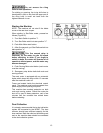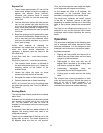
19
Free Cut (Blade to Sliding Table)
The sliding table does not run exactly parallel to
the saw blade. It runs away from the back teeth
by a fraction of a millimeter. This is called "free
cut."
A very slight amount of free cut is desirable to
avoid the problems of back cutting due to saw
blade flutter. All saw blades vibrate to some
extent. They flutter less at the front, where the
cutting teeth are held stable by the material,
than at the back.
If the table were set absolutely parallel to the
saw blade, the back teeth could contact the
material and spoil the clean cut achieved by the
front teeth. As the back teeth are ascending,
they could cause chip out on the top surface of
laminated boards.
The free cut required is less than .05 mm over
one meter of travel.
A dial indicator is not required. You can use your
ears to compare the noise of the front teeth with
that of the back teeth. To do this will require a
workpiece shorter than the distance between
front and back teeth. The saw blade should be
raised to its maximum height to achieve the
most contrast.
1. Lay the workpiece against the crosscut
fence and make a cut.
2. Hold the workpiece firmly after the front
teeth have cut and push it on past the back
teeth. As you pass the back teeth you
should feel rather than hear a slight tingling
or whisper. If there is no sound from the
back teeth, you probably have too much
("positive") free cut. If the noise from the
back teeth is similar to that of the front teeth,
there is too little ("negative") free cut and the
table is running in towards the back of the
blade.
3. Having passed the back teeth, stop level
with the riving knife and cut backwards. The
back teeth will make a noise as they are
now cutting the material.
The workpiece must be held
down firmly when making this backward cut.
4. As you continue past the front teeth, the
noise from the front teeth should be equal to
or slightly less than the noise from the back
teeth. Slight back cutting on the backstroke
equals slight free cut on the forward stroke.
5. If the front teeth make more noise than the
back, the free cut is positive; if they make no
noise, the free cut is negative. If the noise
relationship front teeth to back teeth on the
forward stroke is the same as the noise
relationship back teeth to front teeth on the
back stroke (on a scale of 100, 100/30 in
each case), the sliding table is running
exactly parallel to the blade (zero free cut).
To correct the free cut, one end of the sliding
table must be moved outward or inward. It
doesn't matter whether you move the left or the
right end. The only consideration is that there is
enough clearance between the sliding table and
the fixed cast iron table at the end you are
moving.
1. At the end you have decided to move,
loosen the hex nut (A, Figure 38) holding the
sliding table to the frame.
Figure 38
2. Loosen the other two hex nuts in the middle
of the sliding table so that the table will pivot
at the remaining fixed end.
3. Move the table end in or out as needed then
retighten the table mounting nuts.
4. Check again to confirm the free cut is
satisfactory. Repeat the process if needed.
NOTE: The sliding table should be
approximately 0.3 mm higher than the fixed cast
iron table (thickness of a piece of paper). This is
pre-set at the factory, but if adjustment should
ever be needed, use the four height adjustment
bolts (Figure 38) on each end of the table.
Trouble-shooting Free Cut
(Blade to Sliding Table):
Symptoms of positive free cut:
Back cutting on rip fence side. Workpiece on
cast iron table pulled into back of sawblade.
Chip out on top.
Machine cutting out of square. Workpiece
moves slightly on sliding table due to pressure of
saw blade, without operator noticing.


















